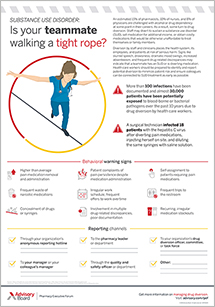Auto logout in seconds.
Continue LogoutRead Advisory Board's take: How clinicians should respond to this clarification
In response to concerns about increasing coverage denials for opioids, CDC officials in a letter sent last month to three oncology organizations clarified that its 2016 opioid prescribing guidelines should not be used to deny opioid drugs to patients experiencing chronic pain caused by cancer or sickle-cell disease.
Background
CDC in March 2016 released prescribing guidelines for opioid painkillers that were designed to stem overprescribing practices, which have contributed to increasing opioid misuse.
The guidelines recommended that primary care providers, who prescribe almost 50% of opioid painkillers, offer chronic pain patients, who receive about 70% of opioid prescriptions, alternative treatments for chronic pain.
When opioid drugs are necessary for treatment, CDC suggested that providers prescribe the lowest possible dosages that would still be effective.
In addition, CDC said opioids prescribed to patients with short-term, acute pain should be limited to no more than a three-day supply in most cases. The agency noted that opioid prescriptions for more than a seven-day supply "will rarely be needed."
CDC said the guidelines do not apply to patients receiving cancer treatment or end-of-life or palliative care. The guidelines are nonbinding and physicians cannot be penalized for non-compliance.
However, the American Society of Clinical Oncology (ASCO), the American Society of Hematology (ASH), and the National Comprehensive Cancer Network (NCCN) expressed concern that the guidelines might limit access to opioids for cancer survivors, cancer patients with chronic pain, and patients with sickle-cell disease.
CDC clarifies 2016 guidelines
ASCO, ASH, and NCCN last week announced that Deborah Dowell, CMO at CDC's National Center for Injury Prevention and Control, in a letter sent to the organizations in March clarified that the agency's opioid prescribing guidelines are "not intended to deny any patients who suffer from chronic pain from opioid therapy as an option for pain management."
Dowell in the letter explained that the guidelines were established to "provide recommendations for primary care clinicians who prescribe opioids for chronic pain outside of active cancer treatment, palliative care, and end-of-life care," and "to ensure that clinicians and patients consider all safe and effective treatment options for patients."
Dowell added that providers should base decision-making regarding opioid drugs on "the relationship between the clinician and patient, with an understanding of the patient's clinical situation, functioning, and life context, as well as careful consideration of the benefits and risk of all treatment options, including opioid therapy."
Your top resources for combatting the opioid epidemic in one place
Groups say clarification could improve access to opioids for patients in need
Representatives of ASCO, ASH, and NCCN in a statement said Dowell's letter could improve access to opioid drugs for patients with "legitimate needs" for medications.
ASCO CEO Clifford Hudis said the letter is "critically important because, while the agency's guideline clearly states that it is not intended to apply to patients during active cancer and sickle-cell disease treatment, many payers have been inappropriately using it to make opioid coverage determinations for those exact populations."
National surveys of cancer patients and survivors sponsored by the American Cancer Society revealed that the portion of patients who were denied insurance coverage for an opioid prescription increased from 11% in 2016 to 30% in 2018. Additionally, more patients reported issues finding a pharmacy to fill their opioid prescriptions, as well as restrictions on the number of opioid pills and refills they could receive.
NCCN CEO Robert Carlson said, "CDC's acknowledgement that clinical decision-making should be based on the relationship between physicians and their patients is important," adding that providers have to find a balance between the risk of opioid misuse and the importance of ensuring that chronic pain patients do not endure "unnecessary, severe pain."
Carlson said oncology and other medical organizations will post the letter on their websites for providers and patients who are challenging opioid prescription denials (Bankhead, MedPage Today, 4/9; McCullough, Philadelphia Inquirer, 4/10).
Advisory Board's take

Rebecca Tyrrell, Practice Manager, Pharmacy Executive Forum and Colleen Keenan, Senior Analyst, Pharmacy Executive Forum
Many hospitals and health systems have excluded palliative care and cancer patients from their opioid stewardship efforts (i.e., they do not limit their opioid-related therapy) because of the long-term pain associated with their diagnoses. However, other chronic pain patients have not historically been exempted from opioid prescribing guidelines. CDC's recent clarification was much needed for this set of patients, especially for those who experienced a change in their routine medication regimen because of the agency's 2016 opioid prescribing guidelines. The explicit acknowledgement that the guidelines should not prevent chronic pain patients from receiving the necessary and appropriate medication to treat their pain—even if that means opioid therapy—is certainly a relief for these patients whose care may have been limited over the past several years.
That said, clinicians still need to make appropriate, informed prescribing decisions for each of these complex patient populations (i.e., palliative care, cancer care, and chronic pain patients) and, in particular, find a balance between over- and under-prescribing opioids. Clinicians can still use CDC's guidelines as a starting point and then take other considerations, like opioid risk assessment tools, alternative treatment options (e.g., physical therapy, acupuncture, non-opioid pain relievers), and the patient's circumstances into account—rather than feeling limited to prescribe only within CDC's suggestions.
To learn more about these other tools, and learn how your organization can play an active role in treating opioid addiction and preventing opioid abuse, make sure to visit our page with your top resources for combatting the opioid epidemic.
Access our resources on the opioid epidemic
The opioid epidemic is a complex, multi-dimensional public health problem. Use this list of helpful resources on how hospitals and health systems can play a role to treat opioid addiction and prevent further increase in opioid abuse.
Don't miss out on the latest Advisory Board insights
Create your free account to access 1 resource, including the latest research and webinars.
Want access without creating an account?
You have 1 free members-only resource remaining this month.
1 free members-only resources remaining
1 free members-only resources remaining
You've reached your limit of free insights
Become a member to access all of Advisory Board's resources, events, and experts
Never miss out on the latest innovative health care content tailored to you.
Benefits include:
You've reached your limit of free insights
Become a member to access all of Advisory Board's resources, events, and experts
Never miss out on the latest innovative health care content tailored to you.
Benefits include:
This content is available through your Curated Research partnership with Advisory Board. Click on ‘view this resource’ to read the full piece
Email ask@advisory.com to learn more
Click on ‘Become a Member’ to learn about the benefits of a Full-Access partnership with Advisory Board
Never miss out on the latest innovative health care content tailored to you.
Benefits Include:
This is for members only. Learn more.
Click on ‘Become a Member’ to learn about the benefits of a Full-Access partnership with Advisory Board
Never miss out on the latest innovative health care content tailored to you.

